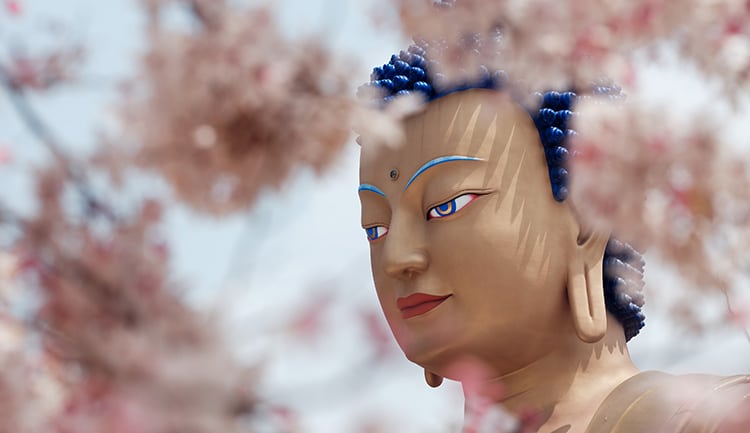What is Aspiration Bodhicitta?
Category: Buddhist Path | Love & Compassion Meditation

How positive intention turns every situation into practice
Aspiration bodhicitta is the practice of using every situation to cultivate positive intent. The important Buddhist term bodhicitta combines two Sanskrit syllables: bodhi, awakening, and citta (pronounced cheeta), heart-mind. While citta is often translated as mind, many Asians associate the mind with the area of the heart, not the head. Fully developed bodhicitta is the heart-mind of those who, like the Buddha, have awakened.
How can we put bodhicitta into practice and experience the heart-mind of an enlightened being? There are two aspects to this.
- The first is aspiration, which is like “I want to go to Prague.”
- The second is application, where we take all the necessary steps to get there.
With these two, aspiration and application bodhicitta, we go from thinking about it to actually traveling to and experiencing Prague firsthand. Likewise, when applied to the Dharma, the aspiration is to attain enlightenment for the benefit of all beings, the application is our practice, whatever form it may take, and the result is the direct, firsthand experience of enlightened heart-mind.
Let’s take a closer look at the bodhicitta of aspiration, which is sometimes called wishing bodhicitta. Aspiration bodhicitta is a full practice in and of itself, yet many practitioners don’t do it justice. Instead of fine-tuning their aspiration or intention, they want to jump straight into the journey. They dive into application bodhicitta by trying to practice generosity, wholesome conduct, patience, joyful perseverance, meditation, wisdom, and so on without having properly refined their mindset. In fact, training in aspiration bodhicitta is an essential practice for anyone starting on the journey, and for years to come.
How do we train? Training in aspiration bodhicitta means we strive to use every situation and every meditation to increase the power of our wish. “May these situations of talking, of listening, of going to work, of preparing a meal, and everything else contribute to the awakening of all beings.” You’re changing a baby diaper: “May changing this diaper contribute to the awakening of all beings.” It sounds so crazy, right? How can changing diapers be a practice of awakening? And then you think, “Of course, I need to do it with an open mind, with full receptivity and presence.” Without a wandering mind, without worrying about the smell, without seeing the infant who objects to wearing their diaper as an opponent.
Let’s take another example: answering emails. How can we use emails as a training ground for bodhicitta? Aspiration is the key. “May the answering of this big long list of emails participate in the awakening of all beings.” And there you go! By composing a nice text, taking care to answer correctly, being fully receptive, letting go of self-importance, and remembering to offer a dedication at the end, answering emails has become a practice.
To give you a better idea of how that could be, the great bodhisattvas and bodhisattvīs—the men and women who have devoted their lives to developing bodhicitta and benefitting others—composed some very powerful wishing prayers. One of the most famous is a passage from the long aspiration prayer-poem by Shantideva—a renowned 8th century Buddhist master from India—called the Bodhicaryāvatāra: The Bodhisattva’s Way of Life. It inspired me very much when I heard it for the first time. In it, he famously says (to paraphrase):
“May I be a guard, a guide, a boat, a bridge, an island, a lamp, a bed, a servant, a wish-fulfilling jewel, a word of power or of supreme healing for countless multitudes of living beings. May I sustain them like the earth, nourish them like water, warm them like fire, bring freshness like the wind, and always provide them with the space they need. May I be their ground of life and their source of sustenance and livelihood until they have all passed beyond sorrow.”
So inspiring! When I first heard it, the bridge was the most important for me. May I be a bridge! It’s so physical, bridging a gap—being a bridge is a wonderful aspiration. Shantideva also says, be a servant. We’re not serving other people’s neuroses here; we’re serving their Buddha nature, the truest and most authentic part of them. Likewise, we endeavor to build bridges of understanding into everyone’s true nature. If I come back to the diapers or the emails, I strive to use those (and all) situations to enter into contact with my own Buddha nature, and to help others connect with theirs.
You can make a constant practice out of forming such wishes in your mind. Don’t miss out on these valuable opportunities. They’re everywhere! We can integrate bodhicitta with everything! Behind the wheel, may we drive all beings to awakening. Opening the door, may we open the gates of liberation for everyone. Each moment, each action, is the basis for a wish.
The practice of cultivating aspiration bodhicitta cannot be overvalued and its potential benefits cannot be overestimated. Everything in this world is the result of motivations and aspirations. To replace our usual self-centered desires and intentions with aspirations that focus on the well-being of others is a fantastic way to change our lives. Simply by focusing on motivation, our whole outlook changes. Consequently, our actions and reactions change, naturally. It’s remarkable how aspiration bodhicitta transforms our lives for the better even when we haven’t explicitly formulated that intention. And it’s all thanks to the raw power of positive motivation.








